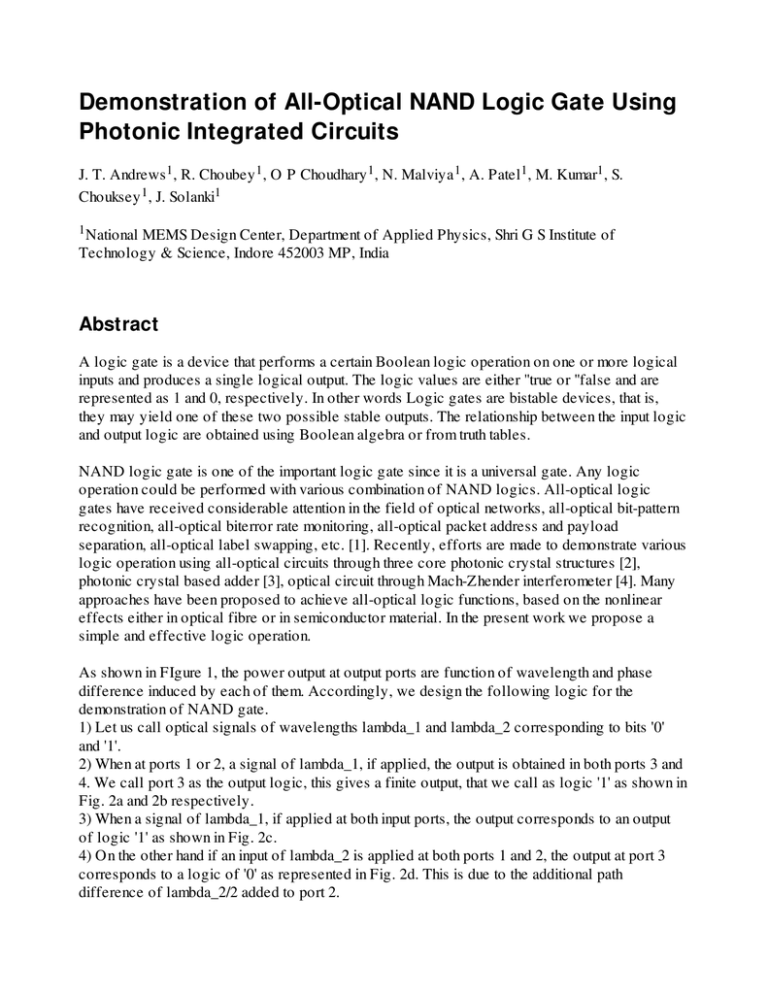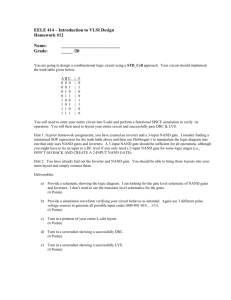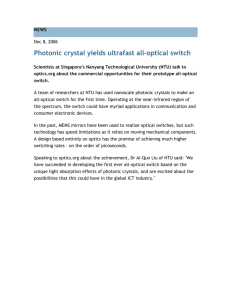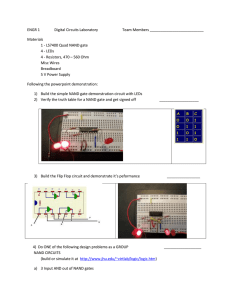Demonstration of All-Optical NAND Logic Gate Using Photonic
advertisement

Demonstration of All-Optical NAND Logic Gate Using Photonic Integrated Circuits J. T. Andrews 1 , R. Choubey 1 , O P Choudhary 1 , N. Malviya 1 , A. Patel 1 , M. Kumar1 , S. Chouksey 1 , J. Solanki1 1 National MEMS Design Center, Department of Applied Physics, Shri G S Institute of Technology & Science, Indore 452003 MP, India Abstract A logic gate is a device that performs a certain Boolean logic operation on one or more logical inputs and produces a single logical output. The logic values are either "true or "false and are represented as 1 and 0, respectively. In other words Logic gates are bistable devices, that is, they may yield one of these two possible stable outputs. The relationship between the input logic and output logic are obtained using Boolean algebra or from truth tables. NAND logic gate is one of the important logic gate since it is a universal gate. Any logic operation could be performed with various combination of NAND logics. All-optical logic gates have received considerable attention in the field of optical networks, all-optical bit-pattern recognition, all-optical biterror rate monitoring, all-optical packet address and payload separation, all-optical label swapping, etc. [1]. Recently, efforts are made to demonstrate various logic operation using all-optical circuits through three core photonic crystal structures [2], photonic crystal based adder [3], optical circuit through Mach-Zhender interferometer [4]. Many approaches have been proposed to achieve all-optical logic functions, based on the nonlinear effects either in optical fibre or in semiconductor material. In the present work we propose a simple and effective logic operation. As shown in FIgure 1, the power output at output ports are function of wavelength and phase difference induced by each of them. Accordingly, we design the following logic for the demonstration of NAND gate. 1) Let us call optical signals of wavelengths lambda_1 and lambda_2 corresponding to bits '0' and '1'. 2) When at ports 1 or 2, a signal of lambda_1, if applied, the output is obtained in both ports 3 and 4. We call port 3 as the output logic, this gives a finite output, that we call as logic '1' as shown in Fig. 2a and 2b respectively. 3) When a signal of lambda_1, if applied at both input ports, the output corresponds to an output of logic '1' as shown in Fig. 2c. 4) On the other hand if an input of lambda_2 is applied at both ports 1 and 2, the output at port 3 corresponds to a logic of '0' as represented in Fig. 2d. This is due to the additional path difference of lambda_2/2 added to port 2. The output corresponding to above cases are also shown in Fig. 3, demonstrating the NAND logic. As discussed above, the operation of using appropriate lambda_1 and lambda_2 generates a truth table corresponding to a NAND logic operation. In conclusion we proposed a novel method for all optical logic operation using simple bidirectional coupler with unequal length of waveguide. The simulated results shows that the logic operation is possible. The truth table established shows the NAND logic operation. Since the logic operations are performed with all optical circuits without the help of any electronic system, ultrafst operations of the order of hundreds of THz could be possible. Reference [1] H. Chen, G. Zhu, Q. Wang, J. Jaques, J. Leuthold, A.B. Piccirilli, and N.K. Dutta, Alloptical logic XOR using differential scheme and Mach-Zehnder interferometer, Electron. Lett., 38, 1271-127 (2002) [2] S. C. Xavier, K. Arunachalam, E. Caroline, W. Johnson, Design of twodimensional photonic crystal-based all-optical binary adder Opt. Eng.52, 025201, (2013). [3] T.Chattopadhyay, Simultaneous logic operations and their inverse in a single circuit using simple optical components, Optics laser Technology, (Elsevier), 48,35-43 (2013). [4] X.-Q. Li, and Y. Xu, Optical sensing by using Photonic Crystal based MachZehnder interferometer, Opt. Commun., in Press, 2013. [5] R. G. Hunsperger, “Integrated Optics: Theory and Technology”, Springer, Berlin (2009). Figures used in the abstract Figure 1: The dual channel waveguide used a optical logic circuit to demonstrate NAND operation. Figure 2: Demonstration of NAND logic operations. Figure 3: The input and output signals at ports 1,2 and 3,4. The signals corresponding to each ports are shown in table 1 for better understanding of NAND operation.





